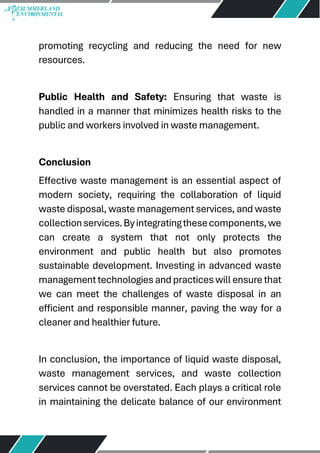The smart Trick of Reclaim Waste That Nobody is Discussing
The smart Trick of Reclaim Waste That Nobody is Discussing
Blog Article
Some Known Questions About Reclaim Waste.
Table of ContentsRumored Buzz on Reclaim Waste4 Easy Facts About Reclaim Waste DescribedThe Definitive Guide for Reclaim WasteThings about Reclaim WasteHow Reclaim Waste can Save You Time, Stress, and Money.
Domestic sewage waste refers to the waste and products from a property septic storage tank. The appropriate monitoring and disposal of domestic sewage waste require liquid waste to be moved to a sewage therapy plant where the correct approaches and tools are applied to purify and dispose of waste.
Industrial waste often consists of prospective risks, such as flammable products or a blend of fluid and strong waste products, and needs an advanced and in-depth disposal process. The disposal of business waste usually entails the filtration of waste prior to transport to make certain safe and correct disposal. Industrial waste is produced from byproducts and drainage of commercial processes and production.
This kind of waste can not make use of the same sewage management transportation or processes as septic or commercial fluids. The hazardous waste monitoring process calls for the assessment and testing of liquid waste prior to it goes through the disposal procedure (liquid waste removal). Drainage waste is the fluid waste that comes from drainage and excess stormwater in extremely inhabited areas or cities
Runoff waste can trigger contamination and flooding if not handled effectively. Guaranteeing correct waste management can prevent calamities and decrease environmental harm.
Not known Facts About Reclaim Waste
Contact PROS Services today to discover our waste administration and disposal solutions and the correct ways to take care of the fluid waste you produce.
(https://hearthis.at/leon-aube/set/reclaim-waste/)Do you recognize what takes place to your water when you pull the plug, flush the commode or drain pipes the washing machine? No? Well, it deserves knowing. This so-called 'wastewater' is not just a vital resource however, after treatment, will be released to our land, waterways or the ocean. Used water from toilets, showers, bathrooms, kitchen area sinks, laundries and commercial procedures is understood as wastewater.

water utilized to cool machinery or clean plant and devices). Stormwater, a form of wastewater, is overflow that streams from farming and metropolitan locations such as roofings, parks, yards, roads, courses and seamless gutters right into stormwater drains pipes, after rainfall. Stormwater streams untreated straight to neighborhood creeks or rivers, eventually reaching the ocean.
Reclaim Waste - Questions
In Queensland, a lot of wastewater is treated at sewer therapy plants. Wastewater is transferred from domestic or commercial sites with a system of sewage systems and pump stations, referred to as sewage reticulation, to a sewage therapy plant. City governments develop, preserve and operate most sewer therapy plants. Operators are accredited under the Environmental Protection Act 1994 to discharge treated wastewater at an acceptable ecological criterion right into rivers.
The Department of Natural Resources recommends local federal governments about handling, operating and maintaining sewage systems and therapy plants. In unsewered areas, local federal governments might call for owners to install private or house sewage therapy systems to treat domestic wastewater from bathrooms, kitchens, shower rooms and laundries. The Department of Natural Resources authorises making use of household systems when they are confirmed to be effective.
In some new communities, treatment of some stormwater to get rid of trash, sand and crushed rock has actually begun utilizing gross pollutant catches. Wastewater treatment happens in four stages: Removes solid matter.
Utilizes little living organisms knows as micro-organisms to damage down and get rid of staying dissolved wastes and fine particles. Micro-organisms and wastes are integrated in the sludge.
The 8-Second Trick For Reclaim Waste
Nutrient removal is not available in any way sewer therapy plants since it requires expensive specialised devices. It is ending up being much more common in Queensland. Clear liquid effluent created after treatment might still consist of disease-causing micro-organisms. If this effluent is released into rivers such as rivers or the sea, the micro-organisms will eventually die out.

This usually means wastewater has actually to be dealt with why not try this out or contaminants eliminated prior to it can be released to waterways. Many wastewater moves right into the sewerage system. Under the Act, neighborhood federal governments provide authorizations and permits for eco relevant activities (Ages) entailing wastewater releases that might have a neighborhood impact. The department provides approvals and licences to ERAs entailing wastewater releases that may have a local or statewide impact.
The 6-Second Trick For Reclaim Waste
Monitoring offers factual details regarding water high quality and can verify that permit problems are being fulfilled. The details gotten via monitoring gives the basis for making water high quality choices.
Report this page